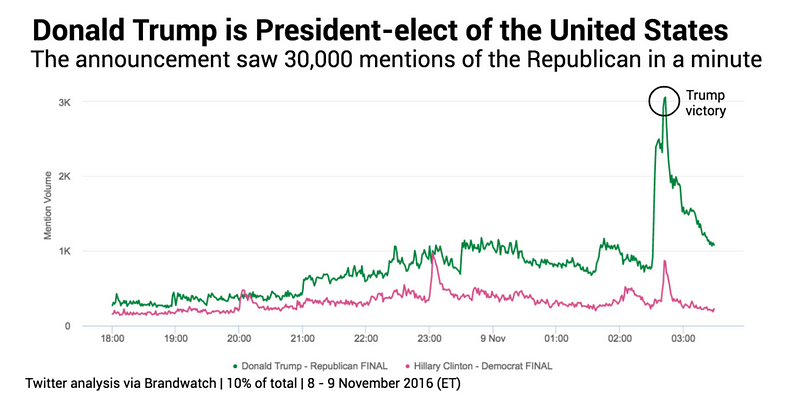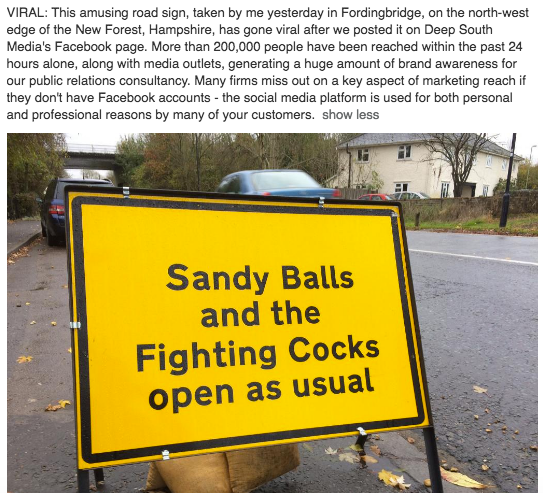When Content Connects Or Makes The Emptiest Of Noise

If the content you create and distribute isn’t aligned to your brand it is meaningless.
You can be provocative, but in tune with your message, or you can be provocative and it doesn’t mean anything apart from the need to be liked by strangers.
There are clicks and shares (consistent with a belief) and there are clicks and shares (a flash in the pan).
The content you share is about relevance that links to your delivery mechanism.
Let me highlight this from two perspectives.
Provocative: Example Of Being In Tune When Content Connects
The BBC published an article called ‘Donald Trump: How The Media Created The President.’ It highlights the role media played in last week’s election win.
Trump was providing more to talk about and saying it in a way that resonated with people to stir an opinion. From building big walls, to water boarding, to deportation, these were larger than life views that were in a different place from the uninspiring approach adopted by the Clinton side .
However, people connected as he was the only one saying something different. Like Brexit, it was controversial but it connected with people.
No one quite new what Trump was going to say next, so the media kept the spotlight firmly on Trump, where he became the media and pulled the strings.
According to Brandwatch, Trump had more Twitter mentions throughout the majority of the election cycle. Between November 8th and November 9th, Trump proudly accumulated 4.9 million mentions whilst Clinton just over 2.7 million mentions.

So, where is the lesson here for the small business world? No one wants a bland point of view that is seen by everyone else, they don’t get clicks and shares. If you can provoke an emotion that comes from consistent behaviour, you stand a far better chance of amplification.
Provocative: An Example On Not Being In Tune When Content Connects
Lets look at the other angle where willingness to share/like, comes from a place of emptiness.
A local company highlighted the merits of viral last week on LinkedIn, by sharing a photo of a holiday park and a pub. If That’s Life was still on TV, this would have got a standing ovation.

According to the MD, with a reach of over 200k people and a ‘huge amount of brand awareness’ they had struck gold. For the company, I’d say this is great publicity, hats off to them. It then asks the questions for us all, how do we capitalise once the fire builds?
If it was a way to bring people back to their site to capture and build an owned audience (there are no sign up forms on the website or any form of data capture), showcase a new initiative or the release of a new product, then it was a very clever tactic.
In reality it was a case of someone taking a photo, putting it on social media and then telling everyone how much an image was shared. It did not mean anything that connected on a deeper level with the brand.
It was more about a funny photo gaining 200k Facebook points. Lets get things straight 200k Facebook points equate to nothing.
So, What Does This Mean?
If the content you share isn’t aligned to your brand and your beliefs, it doesn’t make sense.
Businesses need to stop thinking that collecting eyeballs and a pat on a back from a stranger is a place of acknowledgement.
Just because someone has liked or retweeted doesn’t mean they want to connect on a deeper level to subscribe or spend money with you.
Being popular doesn’t create a better experience, it creates a sense of self-reward. It is a bit like being on the running machine at the gym for 30 minutes on level two, it doesn’t matter if you have been barely walking, the machine said you’d been active for 30 minutes.
Whilst we need to ‘seriously’ entertain our audiences, the messages we portray (controversial, funny, matter of fact, from the heart) has to provide a unique value to an audience that they may not find elsewhere. If you can do this consistently, you can build an audience (and support).
A question to ask yourself, is it better to start a conversation around a set of values, or the equivalent of sharing a video eating a hot pepper and then never be seen again? If you can come from a place of authority and belief, this is far stronger than the flash in the pan that gained reach and then disappeared without trace.
Buzzsumo have recently produced a report where they highlight that content that gets links and shares is linked to the core idea of a belief delivered with conviction. Higher shares and links are associated with: answering popular questions; strong opinion posts; original research and insight; insights from trending topics; authority content related to new products.
If you can provide consistency with your message, your content becomes relevant if the delivery mechanism connects with the right audience. For instance, January 1st 2017, Assasin’s Creed is released in the cinemas. Effectively a $200m advert for a game.
When you create metrics that are associated with your goals, you create a win/win. If wider reach is equated to something you set out to achieve based on a strategic approach, rather than a stand back and ‘aren’t we good’ then you become more meaningful.
Can you create a return based on the conviction you provide, not working to an advertising mindset, based on the quickest return with the shortest amount of effort.
Goals To Consider
Can something you distribute come back to a goal you have set. Some goals to think about:
– grow subscribers — if you have put something out there that has the ability to draw people back to you, what are you going to do once they have arrived? Is it a case of showcasing a new monthly email related to your industry, is it a new guide related to a pain point?
– people to connect with you — rather than send and walk away is there a way that content that is distributed allows a conversation to grow within an owned space, such as email?
– grow new alliances and collaborative partnerships — are you looking to build a network of people that share your viewpoint. Is there a way for others to see inside your head and recognise that bat signal that is being sent to them (this is how my relationship started with my podcast partner, Ian Rhodes. He saw the Talking Content Marketing interviews I was producing, we connected, we then grew the conversation.
– paint a better picture of you in someone else’s life — the seed that you sow from the content that someone else sees, does it have the ability to change behaviour. When they look deeper, they can see continuity.
– educate a new audience — rather than sending out something and moving onto the next project, is there a way to draw people in with a responsibility to educate, inform and challenge. For example, what starts as a funny photo, becomes a link to an overall view and approach.
One thing that I haven’t highlighted here is the goal for more traffic. At the top of the content goal tree, driving more traffic is not about finding the right audience who can connect, but the ambition of pointless of self-promotion. Sometimes it would be easier to pay 20 students for an hour to follow you round the centre of town shouting your name.
How Should We Look At Things
Emotion wins and naturally works. However, businesses need to stop looking at the short term, ‘lets get everyone inside this tent as it’s not going to be here tomorrow’ approach and build validity and a reason for why people should care/connect/buy instead of this online-wonderland nirvana we create that is driven by strangers liking us as a view of validity to what we do.
It may not be sexy, but when you stand true to what you believe in rather than chasing controversy or the next funny photo confirmation from others, at least you do it with meaning and heart.


